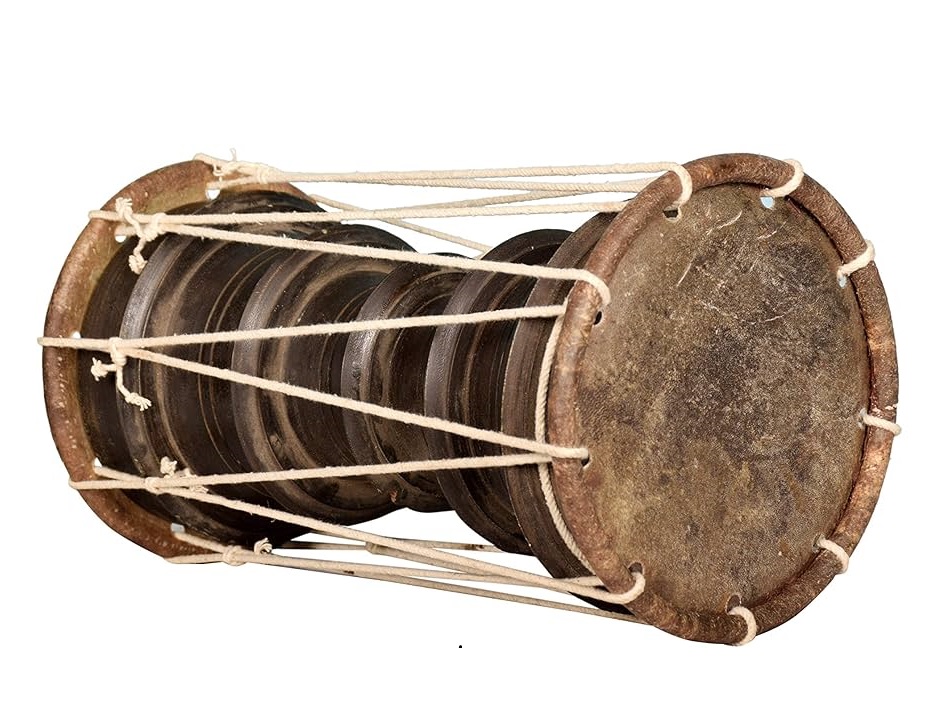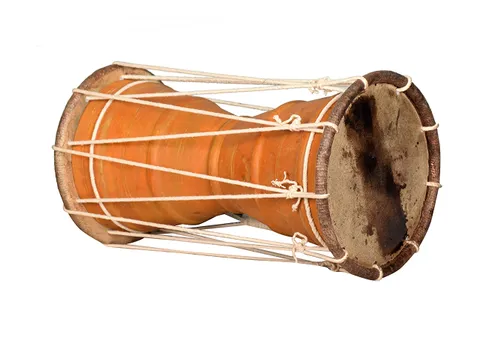Urumi melam
Percussions
Asia
Between 0 and 1000 AD
Video
The Urumi Melam is a traditional percussion instrument that holds cultural and religious significance, especially in the Tamil communities of South India and Sri Lanka. This instrument belongs to the family of membranophones, meaning it produces sound through the vibration of a stretched membrane. The Urumi Melam is known for its distinct shape, playing technique, and deep, resonating sound that has been a crucial element in temple festivals, religious processions, and folk performances.
The Urumi Melam consists of a cylindrical body made of wood or metal, with both ends covered by animal skin. The drum is usually slung around the player’s body using a cloth or strap, allowing the drummer to play both sides simultaneously. Unlike many other traditional drums, the Urumi Melam is played using both hands and sticks, allowing for complex rhythms and unique tonal variations. This drum is categorized as a double-headed drum, and its construction allows it to produce a continuous, rolling sound that can be modified based on the drummer’s skill and style. The instrument is often used in combination with other percussion instruments such as the Thavil, Parai, and Nadhaswaram to create dynamic and rhythmic musical compositions.
History and Origin
The Urumi Melam has a long and rich history that can be traced back to ancient Tamil culture. It originated in South India, particularly in the Tamil Nadu region, and spread to Sri Lanka and parts of Malaysia and Singapore, where Tamil communities have preserved and continued the tradition.
Historians believe that the Urumi Melam dates back several centuries, possibly to the medieval period, when it was an essential component of religious ceremonies and folk traditions. The instrument is strongly associated with Tamil devotional practices, particularly in temples dedicated to Hindu deities such as Murugan, Kali, and Ayyappan. The use of Urumi Melam in religious events has contributed to its survival and importance over the years. Originally, the Urumi Melam was played in village festivals, religious rituals, and war dances. It was considered an instrument of power, used to invoke divine energies and to communicate messages during processions. In ancient Tamil history, percussion instruments played an essential role in battlefields, where they were used to boost the morale of warriors and send coded messages through rhythmic patterns.
As Tamil culture spread through trade and migration, the Urumi Melam found a place in Tamil diaspora communities across Sri Lanka, Malaysia, and Singapore. It became an essential part of cultural festivals in these regions, maintaining its deep connection to traditional Tamil identity and heritage. Today, the Urumi Melam continues to be played in temples, cultural festivals, and street performances, preserving its legacy as a vital instrument of Tamil musical and spiritual traditions.
Types and Features
Types of Urumi Melam
The Urumi Melam exists in different variations, depending on its size, material, and the purpose of its use. While the basic structure remains the same, different types of Urumi Melam drums can be categorized based on their design and playing style.
Temple Urumi Melam is the most traditional form of the instrument, played during temple festivals and religious processions. It is often accompanied by chants and prayers, creating a spiritually uplifting atmosphere. Folk Urumi Melam is used in village celebrations and folk performances, this type is slightly smaller and more portable. It is commonly played alongside other folk instruments such as the Parai drum. Festival Urumi Melam is larger and louder version designed for grand celebrations and cultural parades, often featuring multiple drummers playing in unison to create a powerful rhythmic experience. Some contemporary musicians have adapted the Urumi Melam into fusion music, combining it with electronic beats and other modern elements while maintaining its traditional essence.
Features of the Urumi Melam
The unique features of the Urumi Melam make it distinct from other drums.
Shape and Construction: The drum is cylindrical, usually measuring around 2 to 3 feet in height. The wooden or metal body provides resonance, while the stretched animal skin at both ends helps produce its characteristic sound.
Double-Headed Nature: Unlike many other drums that are played on one side, the Urumi Melam is played on both sides simultaneously, creating a continuous flow of rhythm.
Flexible Playing Technique: Drummers can use both their hands and sticks to produce different tones, making it a highly versatile instrument.
Dynamic Sound: The sound of the Urumi Melam can range from deep and thunderous to sharp and fast-paced, depending on the player’s skill and technique.
Work Mechanics and Playing Technique
The mechanics of playing the Urumi Melam are unique and require specialized skills. Unlike single-sided drums, which rely on a single striking surface, the Urumi Melam requires coordination between both hands to maintain a continuous rhythm. The drum is usually played while slung across the body, either around the waist or over the shoulder. The player strikes one side with their dominant hand while using the other hand to produce complementary beats. In some cases, a stick is used in one hand to create sharper and more precise beats, adding variety to the rhythm.
Since the Urumi Melam is a double-headed drum, drummers must develop a unique hand coordination technique. This technique allows for intricate rhythmic patterns that can be fast-paced and hypnotic. The rolling beats produced by the Urumi Melam are often used to build excitement and energy, making it an essential instrument in celebratory and ritualistic settings. Another key aspect of Urumi Melam playing is its connection to dance and movement. Many performances feature drummers moving in sync with the beats, adding a visual element to the musical experience. This dynamic interaction between rhythm and movement enhances the overall impact of the instrument in cultural performances.
Role in Music
The Urumi Melam plays a significant role in Tamil music, both in religious and folk traditions. It serves as a rhythmic backbone in many traditional performances and continues to influence contemporary music.
The Urumi Melam is most commonly associated with Hindu temple rituals and processions. It is played during festivals such as Thaipusam, Panguni Uthiram, and Aadi Perukku, where it accompanies devotional songs and prayers. In rural Tamil Nadu, the Urumi Melam is a key instrument in folk music performances. It is used in village festivals, storytelling traditions, and dance forms like Kavadi and Kummi. The instrument is often played in street processions, particularly during temple car festivals and spiritual gatherings. Its powerful sound helps create a celebratory atmosphere. Modern Tamil musicians have integrated the Urumi Melam into fusion music, combining it with electronic beats and Western instruments. This has helped introduce the instrument to a global audience.
Significance of the Urumi Melam
The cultural and spiritual significance of the Urumi Melam extends beyond its musical function. It is deeply embedded in Tamil traditions and continues to be an instrument of identity, community, and devotion.
Religious Significance: In Hindu rituals, the Urumi Melam is believed to have the power to invoke deities and create a sacred atmosphere. The sound vibrations are thought to purify the environment and elevate the spiritual energy of a gathering.
Cultural Identity: The Urumi Melam is a symbol of Tamil heritage and pride. It has been passed down through generations and remains a key element of Tamil musical traditions.
Community Bonding: The instrument is often played in groups, fostering a sense of unity and collaboration among musicians and devotees. The communal nature of Urumi Melam performances strengthens social and cultural ties.
Healing and Trance: In some traditions, the rhythmic beats of the Urumi Melam are believed to induce trance-like states, allowing devotees to connect with the divine and experience spiritual healing.
The Urumi Melam is more than just a musical instrument—it is a bridge between tradition and spirituality, carrying the essence of Tamil culture across generations. Its unique design, complex playing technique, and deep-rooted significance in religious and folk traditions make it one of the most treasured percussion instruments of South India.
Despite modernization, the Urumi Melam continues to thrive in temple festivals, street performances, and contemporary fusion music. As Tamil communities across the world preserve and celebrate their cultural heritage, the Urumi Melam remains a powerful symbol of rhythm, devotion, and identity.
FAQ
How does the urumi melam produce its distinctive sound?
The urumi melam produces its distinctive sound through the use of a double-headed hourglass-shaped drum. Players strike the drumheads with their hands to create a variety of tones and rhythms, contributing to the ensemble's energetic beats.
What type of music is typically associated with urumi melam?
Urumi melam is typically associated with Tamil folk music, particularly in the context of Hindu festivals and temple ceremonies. It is known for its vibrant and heart-pounding beats.
What role does urumi melam play in cultural events?
Urumi melam plays a significant role in cultural events by providing an energetic and engaging musical experience. It is integral to creating a lively atmosphere during festivals and temple ceremonies, fostering community engagement and celebration.
 Links
Links
References
Other Instrument
Categories



















